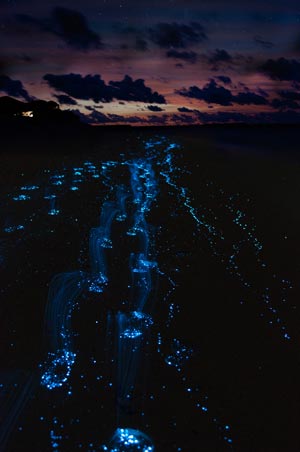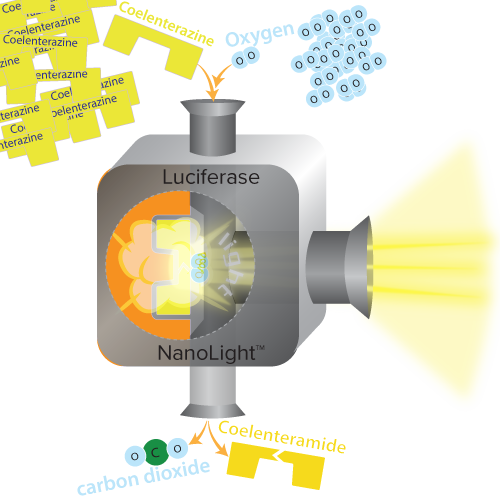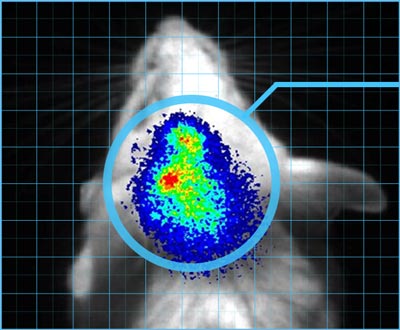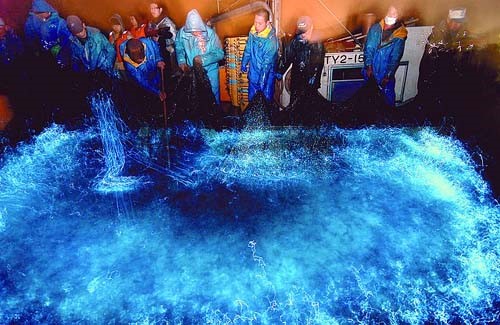BioLume®, Inc. is a privately-held biotechnology company located in Pinetop, Arizona. Our mission is to develop and commercialize a portfolio of proprietary bioluminescent (light producing) enzymes with many first-in-class applications in the food, beverage, cosmetic, personal care, and medical imaging markets.
 BioLume scientists have discovered, cloned, synthesized, and now manufactures a novel portfolio of natural enzymes from marine organisms that bio-luminesce in the deep-sea. These marine organisms generate light by a chemical reaction known as bioluminescence. These enzymes have broad, well-established applications in biomedical research and drug discovery, and are currently in use by many of the largest pharmaceutical companies in the world in drug discovery applications.
BioLume scientists have discovered, cloned, synthesized, and now manufactures a novel portfolio of natural enzymes from marine organisms that bio-luminesce in the deep-sea. These marine organisms generate light by a chemical reaction known as bioluminescence. These enzymes have broad, well-established applications in biomedical research and drug discovery, and are currently in use by many of the largest pharmaceutical companies in the world in drug discovery applications.
BioLume has acquired one of the world’s largest collection of genetic cDNA libraries and frozen tissues from bioluminescent marine organisms. These tissues have been collected from all over the world and represent a vast genetic resource. BioLume has cloned, and patented, a number of completely new luciferase enzymes for exclusive use by BioLume and its partners (see Technology section).
These same enzymes have clinical potential as medical imaging probes of cancerous tumors. In principle, this imaging approach allows very early surgical intervention to remove such tumors and metastases. Considerable published work of the imaging applications by leading academic investigators using BioLume chemistry in laboratory animals has validated this approach. Furthermore, BioLume has demonstrated the potential of these same “glowing” enzymes in a wide variety of food, beverage, personal care, and cosmetic applications.
Business Strategy
BioLume’s business strategy has two broad components;
- developing and commercializing the medical imaging applications covered by its patents
- developing and commercializing the food, beverage, personal care, and cosmetic applications covered by its patents.
These strategies are complimentary as the data needed for development of either will benefit both components.
However from a funding standpoint, the development process is faster and less expensive for ingredients added to food and other consumer products than medical imaging agents yet the market opportunity is likely larger so BioLume will pursue this first and use the cash from ingredient sales to develop the medical imaging products.
Biolume’s Market Opportunities
 The consumer markets are very large and growing. The broad and diverse consumer applications within foods, beverages, personal care, and cosmetics represent huge first-in-class product opportunities. There are no consumable bioluminescent products on the market today. BioLume has trademarked the brand name Lumoness™ for the combination of chemistry that produces the bright, luminescent glow, in a spectrum of colors, which can be added to a broad range of products in each catagory. Many major consumer product companies have expressed interest in Lumoness because “there aren’t any new foods, just new ingredients.”
The consumer markets are very large and growing. The broad and diverse consumer applications within foods, beverages, personal care, and cosmetics represent huge first-in-class product opportunities. There are no consumable bioluminescent products on the market today. BioLume has trademarked the brand name Lumoness™ for the combination of chemistry that produces the bright, luminescent glow, in a spectrum of colors, which can be added to a broad range of products in each catagory. Many major consumer product companies have expressed interest in Lumoness because “there aren’t any new foods, just new ingredients.”
Biolume bioluminescent enzymes have broad application in medical imaging including anatomic, vascular and molecular imaging. Optical (bioluminescent) imaging represents a paradigm shift in the focus of medical imaging from the visualization of anatomy and physiology to the study of metabolic and physiological processes, such as cancers, at the cellular level, often in real time. Molecular imaging, and specifically bioluminescent imaging (BLI), allows for early diagnosis of disease before there are symptoms or anatomic masses such as tumors. Plus, BLI can be used to quantitatively monitor disease progression and the efficacy of drug therapy non-invasively. Very sensitive optical imaging systems are already marketed that can detect light transmitted through tissue. Many peer-reviewed academic publications on the subject, most using BioLume’s proprietary technology, witness BLI interest. The brand name TumorLight™ has been trademarked for medical imaging applications.
 BioLume scientists have discovered, cloned, synthesized, and now manufactures a novel portfolio of natural enzymes from marine organisms that bio-luminesce in the deep-sea. These marine organisms generate light by a chemical reaction known as bioluminescence. These enzymes have broad, well-established applications in biomedical research and drug discovery, and are currently in use by many of the largest pharmaceutical companies in the world in drug discovery applications.
BioLume scientists have discovered, cloned, synthesized, and now manufactures a novel portfolio of natural enzymes from marine organisms that bio-luminesce in the deep-sea. These marine organisms generate light by a chemical reaction known as bioluminescence. These enzymes have broad, well-established applications in biomedical research and drug discovery, and are currently in use by many of the largest pharmaceutical companies in the world in drug discovery applications. The consumer markets are very large and growing. The broad and diverse consumer applications within foods, beverages, personal care, and cosmetics represent huge first-in-class product opportunities. There are no consumable bioluminescent products on the market today. BioLume has trademarked the brand name Lumoness™ for the combination of chemistry that produces the bright, luminescent glow, in a spectrum of colors, which can be added to a broad range of products in each catagory. Many major consumer product companies have expressed interest in Lumoness because “there aren’t any new foods, just new ingredients.”
The consumer markets are very large and growing. The broad and diverse consumer applications within foods, beverages, personal care, and cosmetics represent huge first-in-class product opportunities. There are no consumable bioluminescent products on the market today. BioLume has trademarked the brand name Lumoness™ for the combination of chemistry that produces the bright, luminescent glow, in a spectrum of colors, which can be added to a broad range of products in each catagory. Many major consumer product companies have expressed interest in Lumoness because “there aren’t any new foods, just new ingredients.” Bioluminescence is light produced by a chemical reaction within a living organism. Usually two substances and Oxygen are required. The substance that produces the light is generically called luciferin, and the substance that drives or catalyzes the reaction is called lucerifase. The chemical reaction from combining these substances is very efficient, producing 98% of its energy as light (
Bioluminescence is light produced by a chemical reaction within a living organism. Usually two substances and Oxygen are required. The substance that produces the light is generically called luciferin, and the substance that drives or catalyzes the reaction is called lucerifase. The chemical reaction from combining these substances is very efficient, producing 98% of its energy as light ( BioLume has a number of proprietary luciferases in its portfolio. These include Renilla and Gaussia. BioLume also has proprietary green fluorescent proteins that can be combined with luciferases to create a spectrum of
BioLume has a number of proprietary luciferases in its portfolio. These include Renilla and Gaussia. BioLume also has proprietary green fluorescent proteins that can be combined with luciferases to create a spectrum of  BioLume bioluminescent enzymes have broad applications in medical imaging including anatomic, vascular and molecular imaging. Optical (bioluminescent) imaging represents a shift in medical imaging from the visualization of anatomy and physiology to the study of metabolic and physiological processes, such as cancers, at the cellular level, often in real time. By tagging molecules with our natural bioluminescent enzymes, it is possible to track the progression of disease and evaluate the efficacy of a therapy. It is also possible to illuminate anatomical features such as tumors, ducts, and arteries. Once the bioluminescent light is produced on the molecular level, a visible light camera is used to acquire images through the tissue. These cameras are commercially available today and are less expensive than X-ray, CT, MRI, Nuclear, ultrasound, and PET equipment. BLI has minimal background activity, and is very sensitive and quantitative.
BioLume bioluminescent enzymes have broad applications in medical imaging including anatomic, vascular and molecular imaging. Optical (bioluminescent) imaging represents a shift in medical imaging from the visualization of anatomy and physiology to the study of metabolic and physiological processes, such as cancers, at the cellular level, often in real time. By tagging molecules with our natural bioluminescent enzymes, it is possible to track the progression of disease and evaluate the efficacy of a therapy. It is also possible to illuminate anatomical features such as tumors, ducts, and arteries. Once the bioluminescent light is produced on the molecular level, a visible light camera is used to acquire images through the tissue. These cameras are commercially available today and are less expensive than X-ray, CT, MRI, Nuclear, ultrasound, and PET equipment. BLI has minimal background activity, and is very sensitive and quantitative. The consumer markets are very large and growing. The broad and diverse consumer applications within foods, beverages, and cosmetics represent huge first-in-class product opportunities. There are no consumable bioluminescent products on the market today. Our brand name Lumoness™ represents the chemistry that produces the bright, luminescent glow, in a spectrum of colors, which can be added to a broad range of products in each category.
The consumer markets are very large and growing. The broad and diverse consumer applications within foods, beverages, and cosmetics represent huge first-in-class product opportunities. There are no consumable bioluminescent products on the market today. Our brand name Lumoness™ represents the chemistry that produces the bright, luminescent glow, in a spectrum of colors, which can be added to a broad range of products in each category. The duration of Lumoness “glow” can vary by formulation, encapsulation, quantity, host product or delivery system and has no discernable taste of its own.
The duration of Lumoness “glow” can vary by formulation, encapsulation, quantity, host product or delivery system and has no discernable taste of its own. Safety is our number one priority; we have done extensive testing to ensure that our products are non-toxic Our goal is to obtain FDA approval on bioluminescent ingredients for food and beverage products.
Safety is our number one priority; we have done extensive testing to ensure that our products are non-toxic Our goal is to obtain FDA approval on bioluminescent ingredients for food and beverage products.


